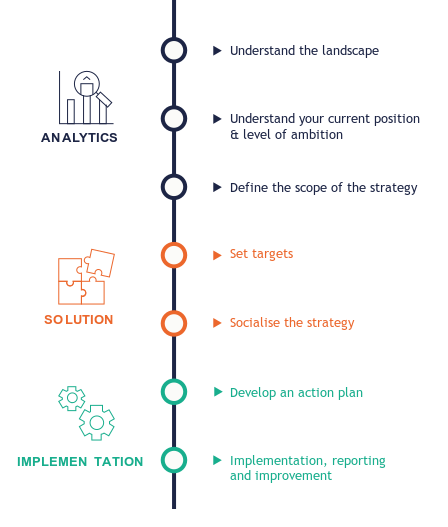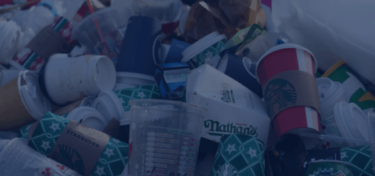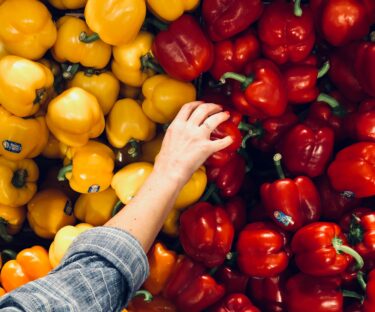

In this guide
- Understand the Landscape
- Understand Where You Are
- Define the Scope
- Set Packaging Targets
- Socialise the Strategy
- Develop an Action Plan
- Implementation
Share this article
Developing Sustainable Packaging Strategies
With plastic and packaging continuing to take a front seat in the news, environmental regulations, NGO campaigns and activism, forward-thinking businesses will have started the journey to make their packaging more sustainable. But with an understanding of complexities such as material substitution options, carbon emissions, and responsible sourcing required to ensure that packaging is truly better for the environment, setting a sustainable packaging strategy can seem like a daunting and complex process.
Anthesis outlines the seven key steps to setting and delivering a successful sustainable packaging strategy
What is a sustainable packaging strategy?
A sustainable packaging strategy is an approach that aims to reduce the negative environmental and social impacts of packaging. This can involve assessing the lifecycle of packaging material options and the availability of waste and recycling infrastructure to process waste materials.
Implementing sustainable packaging strategies can yield significant benefits for brands, including cost reduction, improved environmental impact, compliance with regulations, and increased customer loyalty.
Phase 1: Analytics
1. Understand the landscape
A crucial first step in defining your sustainable packaging strategy is building a clear understanding of the context surrounding your packaging ambitions and needs. This will include the environmental regulations (including extended producer responsibility requirements), NGO and consumer pressures, and the availability of waste recovery infrastructure (e.g. recycling, composting) in your markets. Undertaking this initial research will allow you to map out the key drivers that will shape your strategy and is the first step to narrowing down your packaging options.
Additionally, an understanding of your markets and pre-empting external pressures can be fundamental in keeping a business competitive, financially viable, and compliant with legislation. This is where a robust and dynamic sustainability strategy can positively influence a business’ resilience and adaptability to changing markets.
Fundamental questions to consider when preparing to define your strategy include:
- What are your competitors and other similar organisations doing?
- Who is leading the transition to sustainable packaging in your industry?
- What key industry initiatives are influencing positive change in packaging design and developing waste recovery infrastructure?
- What are the potential collaboration opportunities that would allow you to drive the sustainability of your packaging?
2. Understand where you are and where you want to be
To understand where you are, you must undertake a thorough review of your current packaging portfolio. Questions to address in this step are:
- What types of materials are used in your packaging portfolio and which are considered problematic?
- What percentage of your packaging portfolio is recyclable, compostable or reusable?
- What percentage of recycled content is currently used in your packaging portfolio?
- What is the existing footprint of your packaging? This can be measured by collecting and analysing data on the materials used within your packaging and its impact throughout its entire lifecycle.
Answering and understanding these questions is key to creating the foundations to a holistic strategy with minimised trade-offs between sustainability areas such as recyclability and carbon footprint. Poor sustainability strategies with significant trade-offs can erode brand value especially as the public consciousness and awareness expands to areas of sustainability beyond plastic.
3. Define the scope of the strategy
After reviewing your current performance, your next step should be to set out the scope of the strategy. The following questions should be carefully considered:
- Which packaging materials will be in scope, e.g. all packaging materials or only plastics?
- Which regions/countries will the strategy cover?
- What types of packaging will be included (primary, secondary, tertiary)?
- What definitions will you use when referring to sustainability terms? For example, “recyclable” definitions span from technically recyclable to recycled in practice and at scale, “composting” can mean suitable for home composting or for industrial composting?
Phase 2: Solution
4. Set sustainable packaging targets
Once you have defined the scope of the strategy, you can then set some suitable targets.
Common packaging targets include:
- Reducing packaging weight (This can have positive effects on resource consumption, carbon emissions associated with resourcing materials, production and transport and the fees associated with EPR).
- Increasing recycled content.
- Improving the percentage of packaging that is recyclable, compostable and reusable.
The process of setting targets and ambitious but achievable timescales will involve benchmarking against other organisations and assessing the impact that different interventions will have on your packaging portfolio.
Interventions aimed at meeting particular targets may have a mix of positive and negative impacts on other packaging and wider company targets. For this reason, we recommend prioritising targets to aid decision-making on potential trade-offs. For example, substituting heavy materials with lightweight alternatives could improve the carbon footprint of your packaging and company, but lead to a decrease in recyclability (e.g. substituting glass).
5. Socialise the strategy
Without buy-in from senior management and other key stakeholders, your sustainable packaging strategy cannot be delivered effectively. Once the strategy is defined with the project team, it is essential that it is communicated internally and presented in a way that inspires others to want to be part of your sustainability journey.
In our experience, aligning the strategy with other organisational targets (such as carbon targets) or the organisation’s values can be key to engaging stakeholders.
Once you have agreement from internal stakeholders, communicating your ambition publicly will allow customers to be aware or your intentions and can also help to keep you on track to deliver your strategy.
Phase 3: Implementation
6. Develop an action plan
To meet each goal by the set deadline, a detailed action plan needs to be developed and kept up to date with actions starting at an early stage. Generally, the approach for the action plan will depend on the organisation’s culture. If the organisation is conservative to change you may need a clear roadmap with intermediate steps, or if the culture is more progressive and agile (and perhaps visionary) the strategy can be more adaptable.
Things to consider when developing your action plan:
- Agreed interventions need to be built into the business and resourced appropriately to ensure target deadlines are met.
- Action plans need to be robust enough to proportionately react to external variables whilst keeping to the guiding principles of an organisation’s strategy.
A weak action plan can undermine progress in other regions and the overall company message, strategy, and positioning. Actions, narratives and messaging may need to vary to focus on different aspects of the overall global business strategy depending on the brand, product, target consumer or market geography.
7. Implementation, reporting and improvement
The final stage of implementing your strategy can be the most challenging. The steps here will depend on your targets, but could include:
- Engaging with your supply chain to measure and influence changes to the packaging portfolio
- Sourcing of recycled content
- Investing and/or collaborating with key partners, for example, to ensure packaging is designed for recyclability and recycled in practice
- Keeping up to date with emerging technologies (e.g. advanced recycling)
- Reporting against a packaging baseline to track progress against targets
- Evidencing the sustainability credentials of your new packaging portfolio
- Sharing progress reports through internal and external communication
- Regularly reviewing the landscape to highlight key changes to external pressures
Continuous evaluation of progress towards your targets and the changing landscape in which you operate will allow you to adapt your strategy and action plan to ensure that targets are met and that they meet your potentially increasing ambition.
Our Packaging Expertise
Developing and implementing effective sustainable packaging strategies allows businesses to meet regulatory standards, enhance brand reputation, and minimise environmental impact. Start your journey towards a sustainable packaging strategy today to future-proof your business.
Best Practices for Sustainable Packaging Strategies
To ensure success in sustainable packaging strategies, companies should adopt best practices, including rigorous material assessments, regular supply chain collaboration, and continuous evaluation.
Explore real-world examples of best practices for sustainable packaging strategies and see how leading brands are making an impact.
We are the world’s leading purpose driven, digitally enabled, science-based activator. And always welcome inquiries and partnerships to drive positive change together.










